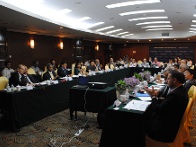Registration
You will receive an email confirming your registration.
IMGXYZ3145IMGZYXChina and India possess a number of similarities in nuclear posture, including their stance on minimum deterrence and no first use. Their advancing missile and missile defense programs, as well as their nuclear modernization programs, have strong implications for strategic stability. More than 40 military, academic, and scientific experts from China and India gathered to discuss these topics during the first part of a two-day Carnegie-Tsinghua Center for Global Policy event, “China and India: Nuclear Doctrine and Dynamics.” Carnegie’s Paul Haenle introduced the session and Carnegie’s Lora Saalman moderated.
Nuclear Consistency versus Evolution
- No First Use: An Indian expert questioned China’s no-first-use (NFU) stance, stating that if a conventional attack against a nuclear facility were launched, China might consider nuclear retaliation. A Chinese panelist disagreed, stressing the verifiability of NFU due to the country’s small arsenal size and lack of tactical nuclear weapons. The Indian expert questioned why China is still diversifying its nuclear weapons if they are for defensive use only, alleging China possesses tactical nuclear weapons.
- Bio-Chemical Weapons: In the event of a biological or chemical weapons attack, India could retaliate with nuclear weapons, according to one Indian expert. Citing India’s ongoing concerns over China’s nuclear cooperation with Pakistan, another Indian expert argued both powers should focus on areas of cooperation, such as concerns over nuclear terrorism and proxy nuclear powers.
- Counter-Value Targeting: China has nuclear weapons targeting an estimated 60 Indian cities, argued one Indian analyst. But a Chinese expert refuted this claim, asserting that none of China’s less than 100 nuclear weapons has been mated to delivery systems. In response, the Indian expert estimated China’s arsenal to contain approximately 400 nuclear weapons.
- Arms Racing: China opposes Mutually Assured Destruction (MAD) because it can lead to an arms race, which only incentivizes continued production, according to one Chinese expert. He explained that China believes nuclear weapons should never be used or produced, but said it was forced down the path of weapons possession by the United States during the Cold War.
Role of Technological Advances
- Misleading Reports: One Chinese expert cautioned Indian delegates not to believe reports about China’s high-tech weapons advances. He stressed that most of these reports are decoys directed at the public to avoid admitting China has a low-technology defense.
- Military Modernization: Indian delegates expressed serious concern about how China’s military expansion will affect Sino-Indian relations. Chinese delegates expressed less interest in India’s military build-up, but strongly urged India to resolve its differences with Pakistan for the sake of regional security. One Indian expert emphasized that China’s support for Pakistan and its military threatens India’s security and creates confusion about China’s true regional and global intentions.
- Missile Defense and ASAT: Both India and China have a ballistic missile defense (BMD) and anti-satellite program. However, China’s program was derived from its Anti-Satellite Test (ASAT)-related hit-to-kill technology, while India’s ASAT program is emerging from its missile defense pursuits, argued one Indian analyst. This expert stressed that India’s BMD program is Pakistan-specific, yet is looking to expand its intercepts to a 5,000-km range. This expanded range could indicate India has begun to factor Chinese ballistic missiles into its future calculations, argued an Indian analyst.
External Actors and Distrust
- International Regimes: Chinese participants strongly encouraged India’s participation in the Nuclear Nonproliferation Treaty (NPT) and Comprehensive Test Ban Treaty (CTBT). Indian delegates argued that NPT membership alone does not indicate a moral high ground—a country’s actions should be the primary determinant. Chinese experts shared their criticism of the NPT, but argued that it remains a cornerstone for international peace.
- Trust Deficit: A number of Chinese delegates expressed surprise at India’s skepticism toward China’s nuclear intentions. One Indian expert argued that for India, the nuclear issue remains central to Sino-Indian security relations. A Chinese delegate responded that the Chinese arsenal is not aimed at India; its peaceful interests are corroborated by such elements as China’s minimal nuclear force structure. Both Indian and Chinese delegates called for increased dialogue as a crucial step toward crisis management and enhanced bilateral understanding.
Discussants: Gu Guoliang, Reshmi Kazi, Nie Hongyi, Kalyan Kemburi, Han Hua, Li Deshun
